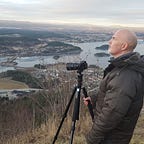A Creative Vision
When I work with an image I want to create something pleasing to eyes, a piece of art with a wow-factor and a scene which takes the viewer on a journey from foreground to background.
In the creative process of editing an image it is therefore very helpful to have a some sort of template which I can use as a guide. Many call this a creative vision. I would never advocate or introduce rules for landscape photography. The core motivation in my photography is the freedom to express myself in whatever artistic fashion I find fulfilling.
However, I have always found it helpful to have some guidelines which outline in which direction I am heading. I am not particularly found of walking blindfolded. There are three main principles I have adopted for my post processing, and I will explain each of them in detail.
From cold to warm
Our eyes are drawn from cold to warm tones. This is one of reasons why warm sunrise or sunset images are so popular on social media. Thinking from cold to warm has significantly impacted how I edit my images. In Lightroom and Photoshop I consciously attempt to manipulate the colors so that my immediate foreground is colder than the background.
The split toning feature in Lightroom, now replaced by Color Grading, is my favorite tool to achieve this effect. I add cold tones to the shadows and warm tones to the highlights, and that usually provides a good starting point for any further post processing.
From high contrast to low contrast
After my senses were opened to this dimension in an image I suddenly saw it everywhere in the photos of the great landscape photography masters. Almost exclusively they go from high contrast to low contrast in their art. If you look closely I you will see how their foregrounds have a high level of contrast, whereas their backgrounds have the opposite quality.
A way of achieving this is to control the blacks throughout a scene. The darkest tones in the foreground are perhaps 90 percent black. The darks in the midground are a tad brighter, and the blacks furthest away even brighter.
From dark to bright
Very often when shooting a waterfall in a dimly lit location like for example a ravine my raw files have a bright foreground while the point of interest, the waterfall itself, is much darker. My eyes abruptly stop at the foreground. The light in the image is so incorrectly distributed throughout the scene that my eyes aren’t led to the focal point.
The use of two radial filters in Lightroom swiftly change the light. The first brightens the waterfall. The second is inverted and darkens everything else. Quite often the only slider I use with the radial filters is exposure.
Sunset or sunrise scenes automatically creates this dark to bright transition because the ground is darker than the sky. In Norway we can have sunsets that last quite a while. As the colors grow in intensity in the sky the ground is becoming increasingly darker. This wide dynamic range is of course a challenge for the camera sensor. However, this can be overcome with the help of filters which darken the sky, or you can shoot bracketed.
What I have outlined above is of course not the key to everything. Not every image or scene fit in the mold, but to have a some sort of idea where you would like to take the image in your post processing is very helpful. To try to create visual paths for the viewer will always create more compelling images.
